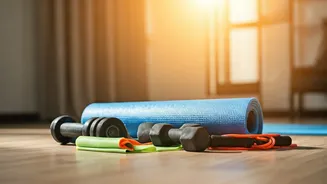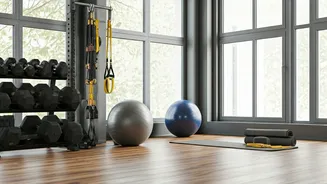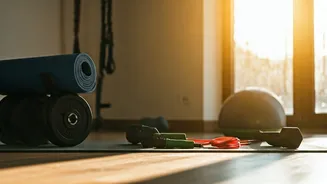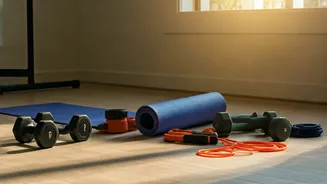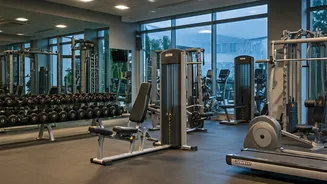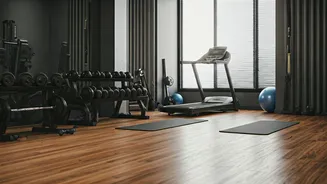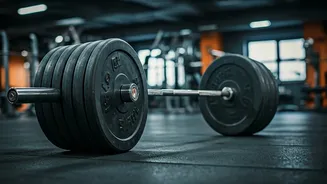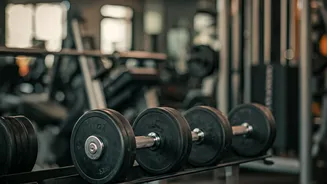Embrace Home Workouts
The popularity of home workouts has surged, presenting a cost-effective and convenient way to stay in shape. With a little creativity and commitment, you
can establish a robust fitness routine in your living room, bedroom, or any available space. The primary benefit is cost-effectiveness; you eliminate gym membership fees, which can quickly add up. Furthermore, home workouts offer unparalleled convenience. You can exercise on your schedule, at any time of day, without commuting. This flexibility is particularly beneficial for those with busy lifestyles. Consider the time saved on travel and the enhanced control over your workout environment, which makes home fitness a compelling option for many people. To successfully start, evaluate the space available and equip yourself with basic necessities, such as a yoga mat and, if desired, some light weights or resistance bands.
Cardio in Your Space
Cardiovascular exercise is essential for heart health and overall fitness. Fortunately, several effective cardio workouts can be performed at home. Jumping jacks are a classic, easy-to-do exercise that quickly elevates your heart rate. High knees and butt kicks are also excellent choices, engaging major muscle groups while improving cardiovascular fitness. For those with more space, running or jogging in place can provide a more intense workout. Dancing is another fun and engaging way to get your cardio in; put on your favorite music and move to the beat. Moreover, consider using online workout videos or apps that provide guided cardio routines. These resources offer diverse workouts, from low-impact options to high-intensity interval training (HIIT), ensuring there is something for everyone. Remember to warm up before each cardio session and cool down afterward to prevent injuries and optimize results. Aim for at least 150 minutes of moderate-intensity or 75 minutes of vigorous-intensity cardio per week for optimal health benefits.
Strength Training Basics
Strength training builds muscle, boosts metabolism, and enhances overall strength. Effective strength training can be done at home with minimal equipment. Bodyweight exercises are a fundamental starting point; push-ups, squats, lunges, planks, and crunches engage multiple muscle groups simultaneously. Modify exercises to match your fitness level; for instance, do wall push-ups or knee push-ups if standard push-ups are too challenging. Resistance bands are affordable and versatile tools that add resistance to your workouts, increasing their intensity. Use them for exercises like bicep curls, tricep extensions, and lateral walks. If possible, consider purchasing a set of dumbbells or kettlebells to further increase the challenge. Focus on proper form throughout your exercises to prevent injuries and ensure effective muscle engagement. Aim for 2–3 strength training sessions per week, targeting different muscle groups each time. Remember to include rest days for muscle recovery and growth. Progressive overload—gradually increasing the intensity, duration, or weight—is essential for continued progress.
Creating Your Routine
Designing a home workout routine that suits your needs and goals is crucial for long-term success. Begin by setting realistic goals; whether it’s losing weight, building muscle, or improving overall fitness, defining clear objectives will help you stay motivated. Schedule your workouts like any other appointment, and block out specific times each week for exercise. Consistency is key, so find times that fit seamlessly into your daily routine. Mix things up by combining cardio and strength training sessions. For example, alternate between a cardio day and a strength training day or integrate both into the same workout. This variety not only keeps your routine interesting but also challenges different muscle groups. Utilize online resources like fitness apps, YouTube channels, and workout guides to find inspiration and guidance. There's an abundance of free and paid resources tailored to every fitness level. Track your progress regularly—measurements, photos, or a workout journal will help you visualize your achievements and stay motivated.
Nutrition and Recovery
Nutrition and recovery are vital components of a successful home fitness plan. What you eat impacts your energy levels, workout performance, and muscle recovery. Focus on a balanced diet rich in whole foods, including lean proteins, complex carbohydrates, healthy fats, and plenty of fruits and vegetables. Ensure you are getting enough protein to support muscle repair and growth, especially after strength training sessions. Hydration is also essential, so drink plenty of water throughout the day, particularly before, during, and after workouts. Getting enough sleep is crucial for muscle recovery and overall health. Aim for 7–9 hours of sleep each night to allow your body to repair and rebuild. Incorporate rest days into your routine to give your muscles time to recover. On these days, consider light activities like stretching or yoga to promote blood flow and reduce muscle soreness. Prioritize these aspects, and you will not only enhance your fitness results but also improve your overall well-being.
